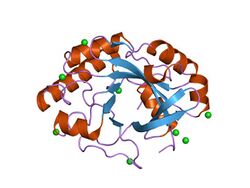Biology:Glycoside hydrolase family 25
| Glycosyl hydrolases family 25 | |||||||||
|---|---|---|---|---|---|---|---|---|---|
 crystal structure of the bacterial lysozyme from streptomyces coelicolor at 1.65 a resolution | |||||||||
| Identifiers | |||||||||
| Symbol | Glyco_hydro_25 | ||||||||
| Pfam | PF01183 | ||||||||
| Pfam clan | CL0058 | ||||||||
| InterPro | IPR002053 | ||||||||
| PROSITE | PDOC00737 | ||||||||
| SCOP2 | 1jfx / SCOPe / SUPFAM | ||||||||
| CAZy | GH25 | ||||||||
| |||||||||
In molecular biology, glycoside hydrolase family 25 is a family of glycoside hydrolases.
Glycoside hydrolases EC 3.2.1. are a widespread group of enzymes that hydrolyse the glycosidic bond between two or more carbohydrates, or between a carbohydrate and a non-carbohydrate moiety. A classification system for glycoside hydrolases, based on sequence similarity, has led to the definition of >100 different families.[1][2][3] This classification is available on the CAZy web site,[4][5] and also discussed at CAZypedia, an online encyclopedia of carbohydrate active enzymes.[6][7]
Glycoside hydrolase family 25 CAZY GH_25 comprises enzymes with only one known activity; lysozyme (EC 3.2.1.17). It has been shown[8][9] that a number of cell-wall lytic enzymes are evolutionary related and can be classified into a single family. Two residues, an aspartate and a glutamate, have been shown[10] to be important for the catalytic activity of the Charalopsis enzyme. These residues as well as some others in their vicinity are conserved in all proteins from this family.
References
- ↑ "Conserved catalytic machinery and the prediction of a common fold for several families of glycosyl hydrolases". Proceedings of the National Academy of Sciences of the United States of America 92 (15): 7090–4. July 1995. doi:10.1073/pnas.92.15.7090. PMID 7624375. Bibcode: 1995PNAS...92.7090H.
- ↑ "Structures and mechanisms of glycosyl hydrolases". Structure 3 (9): 853–9. September 1995. doi:10.1016/S0969-2126(01)00220-9. PMID 8535779.
- ↑ "Updating the sequence-based classification of glycosyl hydrolases". The Biochemical Journal 316 (Pt 2): 695–6. June 1996. doi:10.1042/bj3160695. PMID 8687420.
- ↑ "Home" (in en). http://www.cazy.org/.
- ↑ "The carbohydrate-active enzymes database (CAZy) in 2013". Nucleic Acids Research 42 (Database issue): D490-5. January 2014. doi:10.1093/nar/gkt1178. PMID 24270786.
- ↑ "Glycoside Hydrolase Family 25" (in en). http://www.cazypedia.org/index.php/Glycoside_Hydrolase_Family_25.
- ↑ CAZypedia Consortium (December 2018). "Ten years of CAZypedia: a living encyclopedia of carbohydrate-active enzymes". Glycobiology 28 (1): 3–8. doi:10.1093/glycob/cwx089. PMID 29040563. https://hal.archives-ouvertes.fr/hal-01886461/file/Hehemann_2018_01.pdf.
- ↑ "A classification of glycosyl hydrolases based on amino acid sequence similarities". The Biochemical Journal 280 (2): 309–16. December 1991. doi:10.1042/bj2800309. PMID 1747104.
- ↑ "Sequence of the lyc gene encoding the autolytic lysozyme of Clostridium acetobutylicum ATCC824: comparison with other lytic enzymes". Gene 104 (1): 25–31. July 1991. doi:10.1016/0378-1119(91)90460-S. PMID 1916274.
- ↑ "The N,O-diacetylmuramidase of Chalaropsis species. Identificaiton of aspartyl and glutamyl residues in the active site". The Journal of Biological Chemistry 253 (19): 6787–93. October 1978. doi:10.1016/S0021-9258(17)37988-7. PMID 567645.
 |

